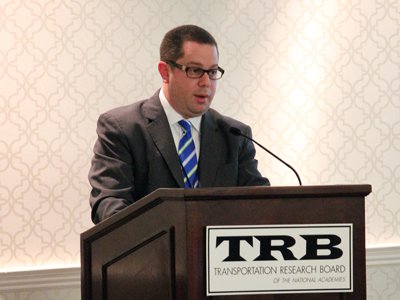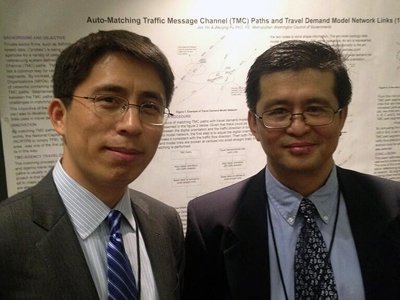More than a dozen planners and engineers from the Transportation Planning Board recently attended a gathering of transportation professionals from around the country and the world to share their latest research and learn from others about recent advances in transportation planning and engineering practice.
The gathering was the 93rd Annual Meeting of the Transportation Research Board, an arm of the National Academy of Sciences, aimed at "promoting innovation and progress in transportation through research." The Annual Meeting is held every January in Washington, DC, and this year attracted almost 12,000 attendees.
The TPB has been sending staff to the Annual Meeting every year for the last few decades in order to learn about the latest research in the field, and also to share the results of the TPB's extensive planning work. This year, three TPB staff gave formal presentations at the conference, which included several hundred sessions or workshops held over four and a half days.
|

|
|
Rich Roisman presents on the TPB's Continuous Airport Systems Planning program at TRB.
|
Air systems planning was the subject of one of the presentations, given by Rich Roisman, a transportation planner who oversees the TPB's Continuous Airport System Planning program. The program has served since the 1970s as a forum for airport planners and operators in the region to share ideas and identify needed upgrades to keep the region's airports functioning efficiently.
In his presentation, Roisman highlighted the TPB's biennial survey of air passengers at the region's three major airports -- Ronald Reagan Washington National, Baltimore-Washington Thurgood Marshall International, and Washington Dulles International. The airports use the survey results to plan for future service and expansion, while transportation planners use the information to identify road, rail, and other improvements needed to ensure good ground access to airports, both for travelers and for freight.
According to Roisman, the TPB is one of just a few metropolitan planning organizations in the country that have incorporated air systems so extensively as part of the larger regional transportation planning process, making his presentation of particular interest to airport operators and regional planners from numerous other metropolitan areas.
Wenjing Pu, a TPB transportation engineer, drew the attention of state highway officials and traffic engineers with his presentation on new ways to measure the traffic impacts of new highway facilities on nearby local roads.
Pu's study measured the "before-and-after" traffic effects of the 2011 opening of the Intercounty Connector in Maryland using GPS-based speed information gathered from travelers who have agreed to share the information anonymously from their smartphones or in-vehicle navigation devices.
The study was one of the first in the country to use such data to measure before-and-after effects. It showed that, after the ICC opened, traffic congestion on nearby local roads dropped, though by a similar share as did the rest of the region -- a likely result of the national economic recession and other factors. On an absolute basis, however, roads in the vicinity of the ICC saw a greater decline in congestion, as the area was already relatively more congested than the region as a whole.
|

|
|
Wenjing Pu and Jim Yin present a poster at TRB about using GPS-data for travel demand modeling.
|
In another application of the same information, Pu joined Jim Yin, a fellow TPB transportation engineer, to share with conference attendees a method for matching the GPS-based speed data to the specific roadway segments used in the TPB's travel demand models. The method makes it possible to compare traffic speeds estimated by the model to traffic speeds observed by GPS, which could be used to improve the model's ability to predict future travel speeds. Pu believes that this is one of the first times a metropolitan planning organization anywhere in the country has done such work.
Besides making presentations at TRB, several TPB staff attended various sessions and participated in meetings of standing TRB committees, which cover a range of topic areas, from travel survey methods, to transportation demand management, to paratransit. The committee meetings guide the research work conducted by TRB and help identify innovations to be featured at future conferences.
The Annual Meeting of the Transportation Research Board is a forum for the exchange of the latest ideas and research in the transportation field. Planners and engineers from the Transportation Planning Board attend each year to share their work, and to learn from others, in order to support continuous innovation and improvements in transportation in the Washington region and around the country and the world.
Special note: This is the 100th issue of TPB Weekly Report! We began publishing more than two years ago, on January 17, 2012. Since that time, we've covered a broad range of the TPB's various research, analysis, outreach, and planning activities. Check out the online archive in the sidebar to access all past issues and learn more about what the TPB has been up to.
Related Links